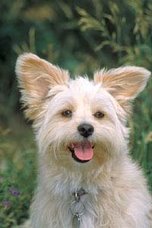In caring for your puppy, one of the most important things you can do is keep a watchful eye on him. If you set up a monitoring routine early on, you will know what your puppy looks like when healthy and can catch illnesses much quicker. Monitoring your puppy does not have to take a lot of time, you can just add a few minutes to his normal grooming session. What are some of the things you should be watching for?
1. Body and Coat - You should run your hands over you puppy's body to check for an tumors or lumps. This can easily be done after the grooming session. You should check your puppy's body for fleas and ticks, when caught early it is much easier to eliminate them. You should keep an eye on your puppy's coat. It should look healthy, be silky and shiny. If it is looking a little dull and a good cleaning and brushing does not bring back its healthy look, you may want to check with your vet.
2. Mouth - There should not be any sores on your puppy's lips or inside his mouth. Check the teeth for any tarter build up. Look at your puppy's gums, they should be pink, without any redness or swelling at the gum lines. Make sure there are not any type of growth or lumps on your puppy's lips or inside his mouth.
3. Nose - Your puppy's nose should be wet. If it is dry then this could be a sign of an illness. There should also not be any discharge coming from your puppy's nose. There should not be any sores in or around the nose, either.
4. Eyes - A little discharge in the corner of a puppy's eyes is nothing to be alarmed about, but a very heavy discharge can be an indication of an eye infection. A puppy's eyes should be clear, no red or yellow coloration to the whites. There should also not be any heavy discharge, discoloration, cloudiness, or tearing in your puppy's eyes, if you notice any of these, consult your vet immediately.
5. Legs - You should inspect your puppy's legs for any swollen joints. Also you should check your puppy's feet periodically for objects caught in the puppy's hair, you should also trim any excess hair. If your puppy does not walk on hard rough surfaces to wear down his toenails, you will need to make sure the are clipped, this is not an indication of illness, just good grooming.
6. Anus - You should check your puppy's rear end for several problems. There should be no swelling in this area, you may notice your puppy scooting his bottom against the ground to relieve swollen glands. You should also check this area for any parasites that may be excreted out (for example, tapeworms, will break into little pieces when they have gone through the elimination process, these little pieces will look like rice) If you notice any of these you need to consult your vet as soon as possible.
7. Ears - You need to check your puppy's ears frequently, at least once a week. You may need to check more often for puppies with long hair or long swinging ears, especially if your puppy has both (i.e. cocker spaniels) You are looking for any discharge or odor. You will need to see your vet for medication if your puppy has any of the following symptoms: a foul odor, if inside the ear is inflamed, red, or hot to the touch, or if your puppy seems sensitive to you touching his ears.
By keeping an eye on these areas, you can be your puppy's best weapon against illness. If you incorporate these checks into your puppy's normal grooming routine, it will be easy to spot if something is wrong.
Subscribe to:
Post Comments (Atom)

No comments:
Post a Comment